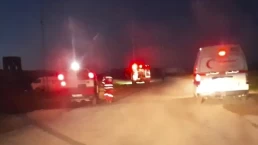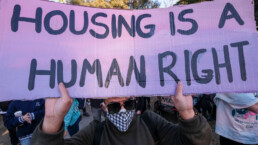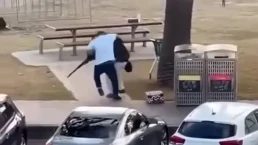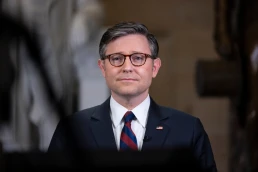Despite video evidence and global outrage, Israeli military report denies executions and offers limited disciplinary action for deadly March 23 attack.
The Israeli military’s internal report on the March 23 killing of 15 medics and a United Nations worker in Gaza has been met with widespread skepticism and renewed calls for an independent investigation, as human rights advocates and analysts accuse the Israel Defense Forces (IDF) of whitewashing potential war crimes.
The IDF’s inquiry concluded that “professional failures, breaches of orders, and a failure to fully report the incident” led to troops opening fire on a convoy of ambulances, a UN vehicle, and a fire truck operated by the Palestine Red Crescent Society (PRCS) and other emergency services. The vehicles were traveling through central Gaza when they came under sustained fire. The report led to the firing of a deputy commander and the reprimand of another officer, which military officials claim should satisfy demands for accountability.

But the findings have been widely dismissed by those monitoring the incident and international law experts. A recent Sky News investigation, including expert analysis of a cellphone video recovered from one of the medics buried in a mass grave, found the IDF’s version of events to be deeply flawed. The video, captured by paramedic Refaat Radwan, contradicted IDF claims that the vehicles were driving without lights or markings and that troops were unable to identify them in the early morning darkness.
Footage showed clearly marked ambulances with emergency lights activated, headlights on, and paramedics wearing reflective uniforms. It also captured gunfire and the medic praying aloud before Israeli soldiers’ voices are heard approaching the convoy. Forensics experts cited by Sky News concluded that shots were fired from as close as 12 meters, challenging the IDF’s assertion that soldiers could not have seen or identified their targets.
The IDF insisted that six of the 15 Palestinians killed were “identified in a retrospective examination as Hamas terrorists,” though it provided no evidence to support the claim. Major General Yoav Har-Even, who led the investigation, stated the individuals would be named at a later time. No documentation or independent verification has been produced.
“For example, [there is] the proposition that six of these people were Hamas, presumably members of Hamas on active [military] service, not people who might have been associated with Hamas in some way. No documentary evidence at all is identified [for that],” said Geoffrey Nice, a human rights lawyer and former prosecutor at the International Criminal Tribunal.
The IDF’s explanation for burying the medics and crushing their vehicles in a shallow mass grave was that it aimed “to prevent further harm and clear the vehicles from the route in preparation for civilian evacuation.” International observers, including United Nations and Palestinian Red Crescent officials, uncovered the mass grave a week later, having been initially unable to reach the site due to security constraints.
“What we know is that we cannot trust the Israeli [military],” said Akiva Eldar, a senior Israeli policy analyst. “Unless The New York Times would have gotten hold of that video clip, I don’t think that we would know the truth. It would be another cover-up.”
The PRCS rejected the findings outright. A spokesperson called the report “invalid” and said it “justifies and shifts the responsibility to a personal error in the field command when the truth is quite different.” Human rights group Breaking the Silence, comprised of Israeli military veterans who oppose the occupation, also condemned the report.
“We all remember when the IDF claimed that the ambulances emergency lights weren’t on—and then we saw the footage proving otherwise,” the group said in a statement. “Not every lie has a video to expose it, but this report doesn’t even attempt to engage with the truth.”
“Another day, another cover-up,” Breaking the Silence added. “More innocent lives taken, with no accountability.”
The IDF has stated there was “no evidence to support claims of execution” and dismissed accusations as “blood libels.” That language has sparked additional criticism, with observers pointing to a long pattern of Israeli military claims being later refuted by independent investigations and journalistic evidence.
Palestinian-American policy analyst Yousef Munayyer argued that the IDF’s internal investigation was only prompted by the release of the video evidence. “Video evidence exposed [the IDF’s] lies forcing this flimsy effort masquerading as accountability so they can sweep it under the rug,” he said.
He added that the lack of immediate skepticism in Western media toward Israeli government narratives enables a cycle of unaccountable violence. “Israel is able to repeatedly attack civilians and aid workers and claim that their deaths were accidental,” he said, “because western media is willing to believe as fact initial Israeli narratives around atrocities.”
In its original account, the IDF claimed that the convoy’s movements had not been coordinated and that the vehicles approached “suspiciously” in the dark with their lights off. After the cellphone footage emerged, the military acknowledged this version was “mistaken” but maintained the troops felt an imminent threat.
Jonathan Whittall, a United Nations official based in Gaza, criticized the findings as inadequate and dangerous. “A lack of real accountability undermines international law and makes the world a more dangerous place,” he said. “Without accountability, we risk continuing to watch atrocities unfolding, and the norms designed to protect us all, eroding.”
Israeli officials presented aerial footage during a press briefing showing that other ambulances were allowed to pass in the hours following the initial attack. They argued this demonstrated that Israeli forces do not indiscriminately fire on medical vehicles, but only when they perceive a threat.
Nevertheless, the attack on March 23 is one in a growing list of deadly incidents involving humanitarian personnel. The IDF dismissed two officers following the April 2024 killing of seven World Central Kitchen aid workers, but international human rights advocates argue such disciplinary actions fall far short of accountability under international law.
The recent escalation in Gaza follows the collapse of a ceasefire deal in mid-March. Israel renewed its offensive on March 18, intensifying operations that began in response to the October 7 Hamas-led attack, which killed 1,200 people and took 251 hostages, according to Israeli authorities.
As of April, Gaza’s Hamas-run Health Ministry reports that over 51,200 people have been killed in the enclave since the start of the conflict. The toll includes thousands of women, children, journalists, healthcare workers, and aid personnel.
“How is this supposed to help the children and families of these medics? …These war criminals should be arrested and handed over to the [International Criminal Court] for due legal processing,” said poet and writer Mosab Abu Toha.
Recent Posts
Democratic Governance Depends On Stable, Affordable Housing
December 16, 2025
Take Action Now A population that cannot afford to stay in one place cannot build civic associations, and a society without civic associations cannot…
The Lobby Is Milking The Bondi Beach Attack To Silence Critics Of Israel’s Genocide
December 16, 2025
Take Action Now It is years of dedicated work by the Israel lobby that has ensured the mass murder of Palestinians is viewed by governments, the…
White House Refuses To Rule Out Summary Executions Of People On Its Secret Domestic Terrorist List
December 15, 2025
Take Action Now The Trump administration ignored questions about whether it would order the killings of those on its NSPM-7 list — even while…
Koch Network Fuels Republican Push To Kill ACA Subsidies
December 15, 2025
Take Action Now As millions face higher premiums, Koch‑funded groups are pressuring Republicans to oppose Obamacare subsidy extensions.By Donald…




